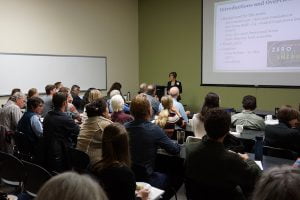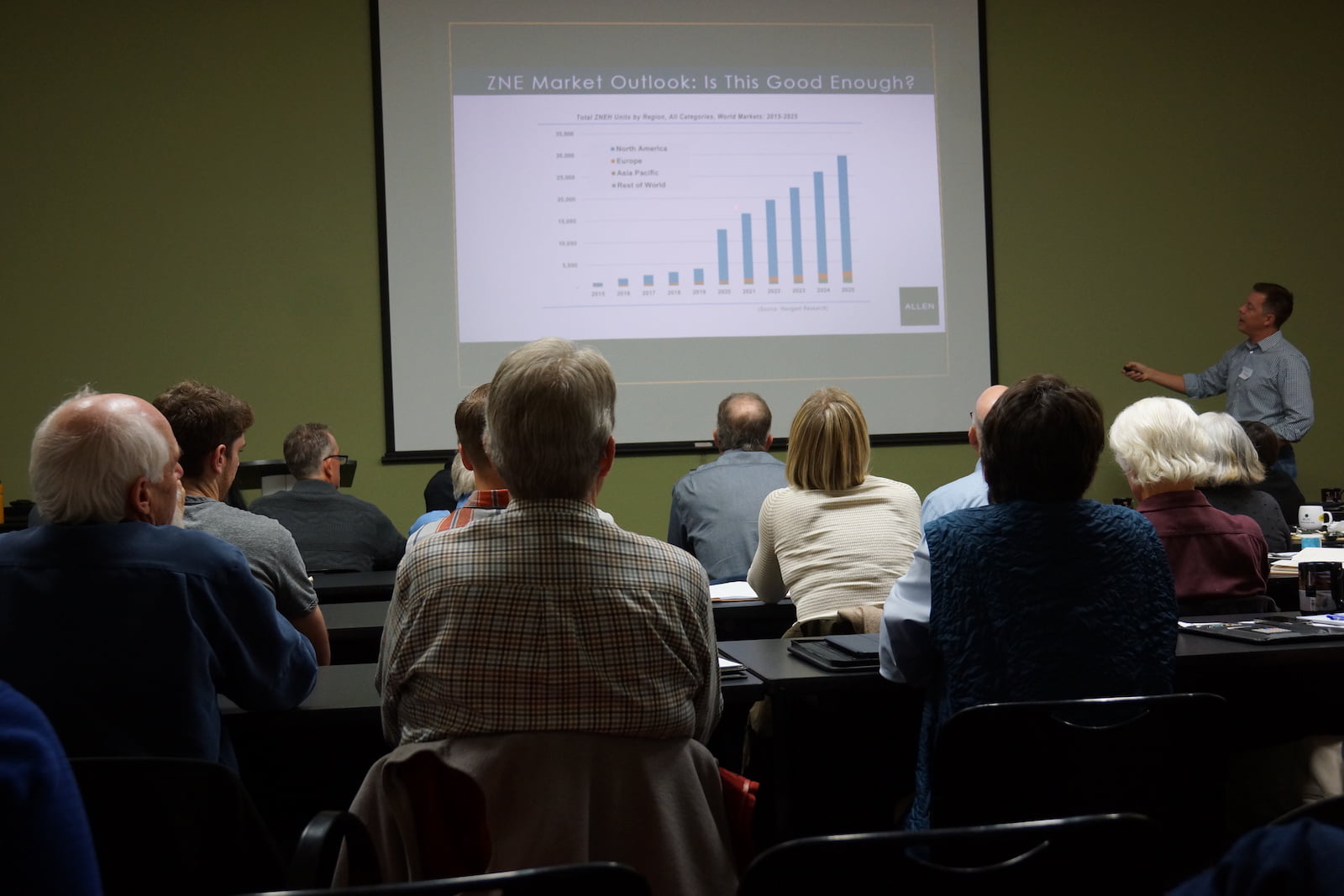The market for zero net energy (ZNE) residential and commercial buildings is growing rapidly and poised for a significant evolutionary leap – if not a boom. Building codes are advancing steadily, zero energy-ready mandates are being implemented in many states, corporations are demanding high performance facilities, and the sleeping giant of consumer awareness is stirring. Designers, architects, builders, and tradespeople need to keep up with these rapid changes. To help them get up to speed local organizations and businesses are stepping up to provide the education these professionals need in order to thrive in the new environment.
A good example of this kind of local initiative is a recent collaboration of two California nonprofits with a local builder and an energy consultant to develop and present their own classes on zero energy design, construction and marketing.
The best NZE training responds to the needs of local communities with their unique climates, cultures, economies, and building practices. Locally developed education is a great way to tap local resources to provide the education building professionals will need in order to thrive in an environment where demand for NZE homes and buildings is growing.
“We knew we needed to do something to make sure our design and building professionals were ready for California’s zero net energy (ZNE) code,” said Andy Pease of In Balance Green Consulting, one of the organizers. “We had 75 attendees, rave reviews, and no organizer burn-out. If that sounds appealing, we humbly offer suggestions for creating a great ZNE learning opportunity, on the cheap.”
Pease recommends six elements for organizing and conducting a successful ZNE training program without stress:
- Set reasonable goals: Make the series simple, affordable, and really good, but perfection is not required. Seek out enough local technical expertise to provide the content without having the expense and coordination of outside speakers. This keeps the price low enough to attract a lot of attendees.
- Conduct the training with a non-profit umbrella: The California program was co-presented by the American Institute of Architecture California Central Coast Chapter and the Central Coast Green Building Council (CCGBC), a local USGBC chapter. Neither organization has professional staff, but an intern provided graphic and web support. The two nonprofit organizations gave the series credibility, and the series gave the organizations recognition and added value for membership. This was a win-win for everyone that can work in any geographic area.
- Form a small steering committee: Dividing tasks between collaborators makes the workload more manageable for everyone. In the case of the California initiative, two firms led the effort: a builder, Allen Construction, and a green building consultant, In Balance Green Consulting. They developed the framework for the training and provided about half of the content. Another eight, hand-picked speakers covered other specific topics. Volunteers handled logistics included advertising, food, venue, and registration.
- Offer a manageable time frame: Consider scheduling meetings at times that make it easy for potential participants to attend. For example, organizers of the California initiative developed a 4-part series that was scheduled from 8 am to noon on the second Tuesday of the month for 4 months. This fit well with the busy schedules of the participants.
- Embrace the value of in-person presentation: There are many great online resources now, but there’s no substitute for the value of personal connection and interaction. Pease’s series partnered with an architecture firm that generously offered the use of their 60-person conference room, with the added bonus that they could video conference the entire series to a remote location. They attracted 60 people in San Luis Obispo and another 15 in their Santa Barbara conference room, watching together by video.
- Keep it inexpensive: The cost to attend was $40/person for the entire series for members of AIA and USGBC, and $60 for non-members. They offered 16 units of continuing education (CEUs), all of which are coveted health, safety and welfare (HSW) units for AIA members. A similar, more commercial course might go as high as $350.
“Any AIA chapter can be a CEU provider,” explained Pease. “The steering committee developed the learning objectives and submitted key presenter resumes, then the Chapter submitted for credit, just as they do for any of the regular lunch meetings or other AIA-sponsored events. Attendees provided their AIA numbers and we made sure they signed in for each class.”
None of the speakers were paid, other than reimbursement for travel, so the only expense was breakfast and snacks. Revenue from registration ($3,000) and sponsorships ($5,000) exceeded the $3,000 in expenses, which was mostly for food. The project netted $5,000 for the non-profits to be used toward funding scholarships.

Grassroots education on zero net energy design drew a full house.
The four sessions covered these topics:
Session 1: ZNE on the Central Coast: What, when and how, policy, codes and climate responsive design for this region
Session 2: Building Science for Effective ZNE, Heat transfer, air sealing and vapor control; energy modeling
Session 3: ZNE Technology as a Partner, Not a Crutch, HVAC, DHW, renewable energy
Session 4: ZNE Performance Verification and Where We Go from Here, Toolbox of strategies, financing, and next steps
Pease and the other organizers hope this example of grassroots education for a zero energy future will inspire professionals in other areas to plan their own courses. An important lesson from this example is to utilize local organizations that already exist, whether that be local AIA or USGBC chapters, or home builders associations, designers associations, trade groups, equipment and material suppliers, environmental organizations, and civic groups.

